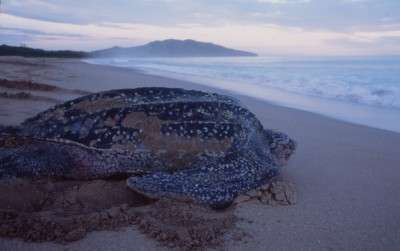Evolutionary egg question answered: Turtle goo reduces oxygen

(Phys.org)—Some reptile species give birth to live young, but turtles have never evolved this ability. New research is revealing why.
PhD student Dr Anthony Rafferty, Associate Professor Richard Reina and Associate Professor Roger Evans from Monash University in collaboration Dr Franciscus Scheelings at Healesville Sanctuary studied four species of turtle and discovered the egg-carrying female had the unique biological ability to wait to lay her eggs on land when conditions were right, giving her young the best chance of survival.
Detailed in the American Society of Naturalists, the study found the egg-carrying females had low oxygen levels in their reproductive tracts, or oviducts. These conditions halted embryonic growth at a certain stage, whereas ova kept at optimal conditions continued to develop normally.
Dr Rafferty, from the School of Biological Sciences, said it was likely the low oxygen environment was actively created by the female and could explain how turtles were able to store eggs by halting development until they could lay them safely on land.
"Surprisingly, live-birth has evolved in over 120 lizard and snake species, but never in closely related crocodile or turtle groups. Until now, the reasons why live-birth has not evolved in these reptile groups were unknown," Dr Rafferty said.
"It appears the female actively produces a mucus-like substance inside the reproductive tracts where the eggs are stored, to lower oxygen levels and cause the eggs to stop developing."
Dr Rafferty said this allowed the turtle to select when and where to lay the eggs on land, taking into account access to adequate food sources and a secure environment.
"After an egg is laid the membrane inside the egg connects and so the egg can't be turned at all or the young will die," Dr Rafferty said.
"We think she wants to stop the development of the egg before it reaches that stage because if she was laying the egg, and it turned at all during the laying, it would die if it were at any further stage of development."
Dr Rafferty said this insight into evolutionary biology had implications for conservation, particularly the preservation of the endangered leatherback turtle because more than half of the eggs laid in each nest never hatch.
"It seems that a lot of the embryo's in those nests are failing to restart developing after they are laid, dying at the stage of development that we're studying," Dr Rafferty said.
"We think that the trigger to restart development is not occurring in these eggs after they are laid and the embryos subsequently die. Further research will give us a better picture of this."
Provided by Monash University














